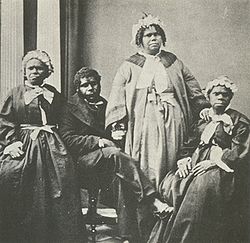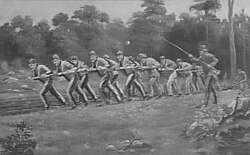Tasmania
Tasmania (Palawa Kani: lutruwita) is a large island off the southern coast of mainland Australia. It is a state of Australia. Its capital and the largest city is Hobart. The island was joined to the mainland until the end of the most recent ice age about 10,000 years ago.
| Tasmania | |||||
|---|---|---|---|---|---|
| |||||
| Slogan or nickname | The Apple Isle | ||||
 Other Australian states and territories | |||||
| Capital city | Hobart | ||||
| Demonym | Tasmanian | ||||
| Government | Constitutional monarchy | ||||
| • Premier | Jeremy Rockliff (Liberal) | ||||
| Population | |||||
| • Population | 571,165 (6th) | ||||
| Elevation | |||||
| • Highest point | Mount Ossa 1,167 m (3,829 ft) | ||||
| Gross state product | |||||
| • Product ($m) | $AU$32.102 billion (8th) | ||||
| • Product per capita | $AU$59,779 (7th) | ||||
| Time zone(s) | UTC+10:00 (AEST) UTC+11:00 (AEDT) | ||||
| Federal representation | |||||
| • House seats | 5/150 | ||||
| • Senate seats | 12/76 | ||||
| Abbreviations | |||||
| • Postal | TAS | ||||
| • ISO 3166-2 | AU-TAS | ||||
| Emblems | |||||
| • Floral | Leatherwood (unofficial) (Eucryphia lucida) | ||||
| • Animal | Tasmanian devil (Sarcophilus harrisii) | ||||
| • Bird | Yellow wattlebird (unofficial) (Athochaera paradoxa) | ||||
| • Mineral or gemstone | Crocoite | ||||
| • Colours | |||||
Tasmania has wonderful natural history, and is the most forested part of Australia. It has the country's largest areas of temperate rainforest. One of its many unique trees is the Leatherwood (Eucryphia lucida). This is a common tree in wet forests, and there are four related species on the mainland.
Tasmania is the home of rare animals such as eastern quolls and Tasmanian devils. It was the last home of the thylacine, which became extinct in 1936.
Brief account
Tasmania is a state of Australia. Unlike the other states, it is an island. The Bass Strait separates it from the Australian mainland.
Australian aboriginals are the native people of Tasmania. Abel Janszoon Tasman landed on the island in 1642. He called it "Van Diemen's Land". It was later called Tasmania. Much later, people came from Europe, mostly from the British Empire, to live on the island.
Cities and towns
Tasmania has four cities: capital city Hobart, Launceston, Devonport and Burnie.
Population
Tasmania is the smallest state in Australia. It also has the smallest population. The total population of Tasmania is just over 500,000 (September 2014).
History
For an history of Tasmania, see Van Diemen's Land.
Darwin Crater
| Darwin Crater Tasmania | |
|---|---|
 False-colour Landsat image of Darwin Crater (arrowed); screen capture from NASA World Wind | |
| Coordinates | 42°18′15″S 145°39′27″E / 42.30417°S 145.65750°ECoordinates: 42°18′15″S 145°39′27″E / 42.30417°S 145.65750°E |
| Population | Lua error in Module:PopulationFromWikidata at line 143: attempt to index field 'wikibase' (a nil value). |
Darwin Crater is a suspected meteorite impact crater in Western Tasmania about 26 km (16 mi) south of Queenstown.
It is just in the Franklin-Gordon Wild Rivers National Park. The crater is a rimless circular flat-floored depression, 1.2 km (0.75 mi) in diameter, in mountainous and heavily forested terrain. It is East of the West Coast Range and the former North Mount Lyell Railway formation.
Places to visit
Tasmania has some of the most popular tourist attractions in the world. They range from old country towns to up to date cities. Some popular tourist places are:
Famous Tasmanians
- Errol Flynn, actor, best known for his role in the 1930s as Robin Hood
- Ricky Ponting, former Australian Cricket Captain
- Peter Crumpton, author
- David Boon, cricket player
- Don Kay, composer
- Madison Courto, musician
- Princess Mary Donaldson of Denmark
- Allanah Hill, fashion designer
- Simon Baker, actor
- Ariarne Titmus, Olympic gold medalist swimmer
- Richard Flanagan, author
- Grace Tame, activist and Australian of the Year
- Mama Soup, tiktok creator
Tasmania Media
Map showing the general geological surface features of Tasmania. Note the extent of dolerite, and the mosaics in the west.
Tessellated pavement, a rare rock formation on the Tasman Peninsula
1807 engraving by French explorer Charles Alexandre Lesueur shows seafaring Aboriginal people and a large canoe on the eastern shore of Schouten Island.
Tasmania is named after Dutch explorer Abel Tasman, the first European to sight the island, in 1642.
Painting by John Glover of Mount Wellington and Hobart, 1834
Four elderly full-blood Tasmanian Aboriginal people, c. 1860s. Truganini, for many years claimed to be the last full-blood Aboriginal person to survive, is seated far right.
A convict ploughing team breaking up new ground at the farm at Port Arthur
References
| Wikimedia Commons has media related to Lua error in Module:Commons_link at line 62: attempt to index field 'wikibase' (a nil value).. |










